Digital Transformation Assignment Solved
VerifiedAdded on 2021/02/21
|14
|4440
|53
AI Summary
Contribute Materials
Your contribution can guide someone’s learning journey. Share your
documents today.
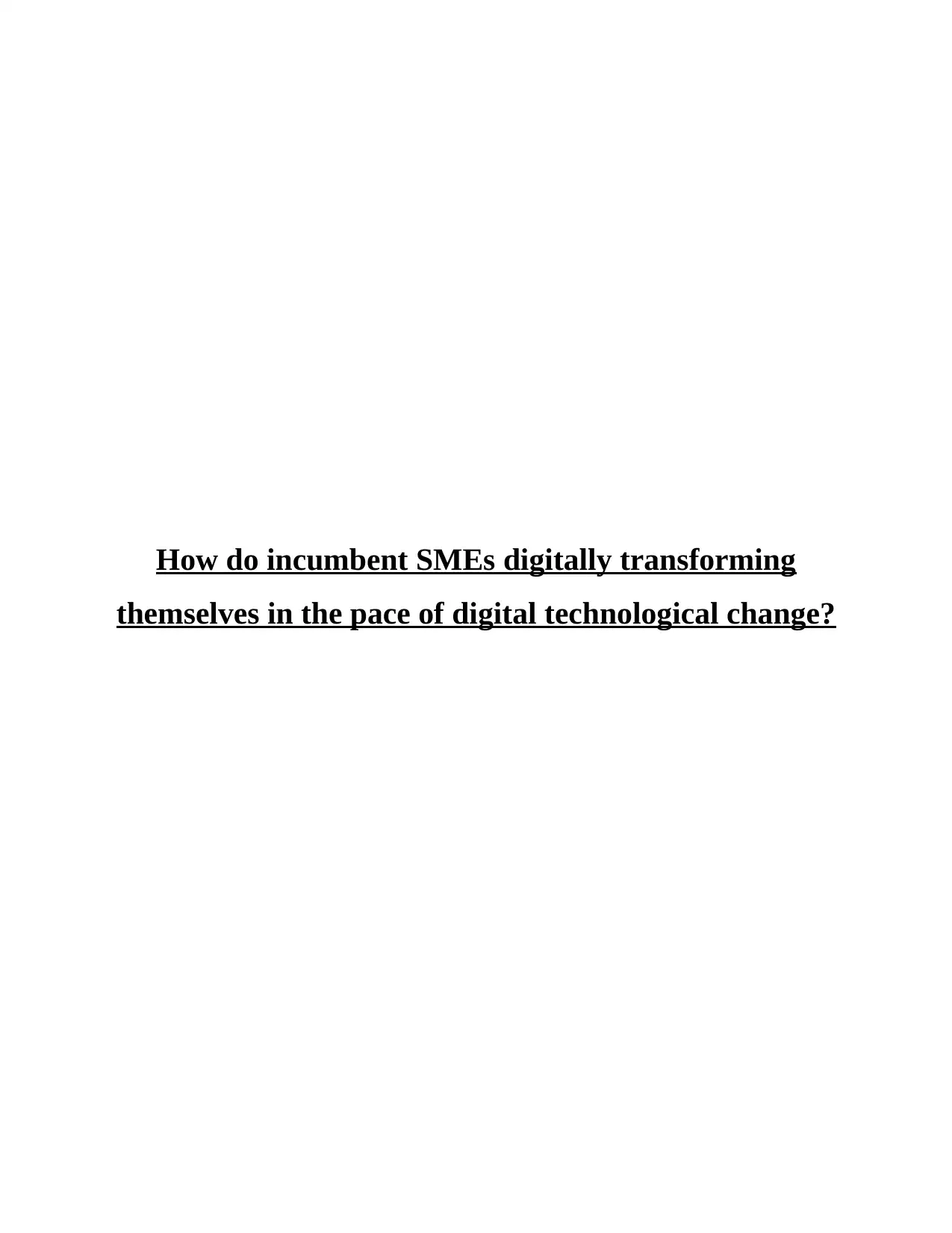
How do incumbent SMEs digitally transforming
themselves in the pace of digital technological change?
themselves in the pace of digital technological change?
Secure Best Marks with AI Grader
Need help grading? Try our AI Grader for instant feedback on your assignments.
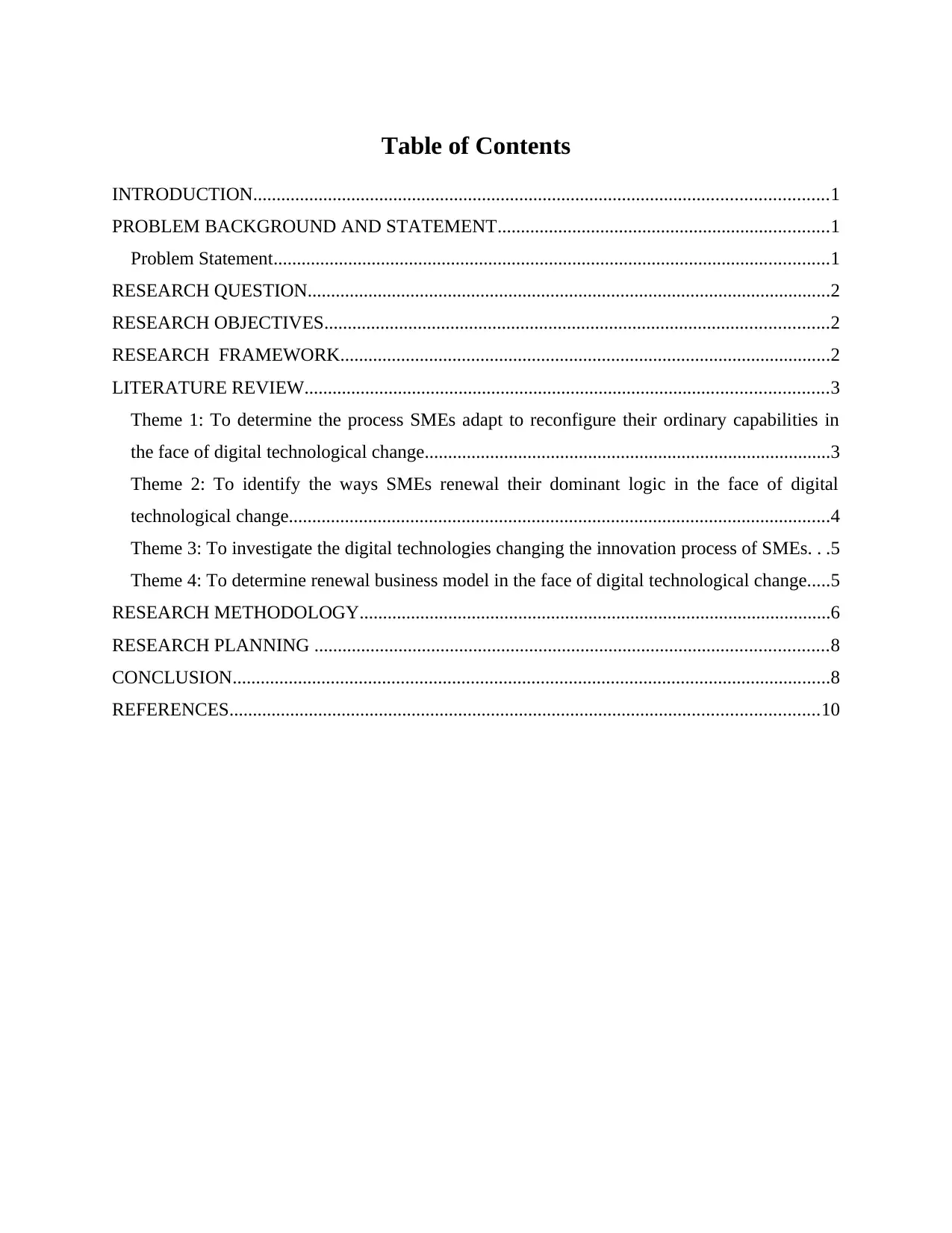
Table of Contents
INTRODUCTION...........................................................................................................................1
PROBLEM BACKGROUND AND STATEMENT.......................................................................1
Problem Statement.......................................................................................................................1
RESEARCH QUESTION................................................................................................................2
RESEARCH OBJECTIVES............................................................................................................2
RESEARCH FRAMEWORK.........................................................................................................2
LITERATURE REVIEW................................................................................................................3
Theme 1: To determine the process SMEs adapt to reconfigure their ordinary capabilities in
the face of digital technological change.......................................................................................3
Theme 2: To identify the ways SMEs renewal their dominant logic in the face of digital
technological change....................................................................................................................4
Theme 3: To investigate the digital technologies changing the innovation process of SMEs. . .5
Theme 4: To determine renewal business model in the face of digital technological change.....5
RESEARCH METHODOLOGY.....................................................................................................6
RESEARCH PLANNING ..............................................................................................................8
CONCLUSION................................................................................................................................8
REFERENCES..............................................................................................................................10
INTRODUCTION...........................................................................................................................1
PROBLEM BACKGROUND AND STATEMENT.......................................................................1
Problem Statement.......................................................................................................................1
RESEARCH QUESTION................................................................................................................2
RESEARCH OBJECTIVES............................................................................................................2
RESEARCH FRAMEWORK.........................................................................................................2
LITERATURE REVIEW................................................................................................................3
Theme 1: To determine the process SMEs adapt to reconfigure their ordinary capabilities in
the face of digital technological change.......................................................................................3
Theme 2: To identify the ways SMEs renewal their dominant logic in the face of digital
technological change....................................................................................................................4
Theme 3: To investigate the digital technologies changing the innovation process of SMEs. . .5
Theme 4: To determine renewal business model in the face of digital technological change.....5
RESEARCH METHODOLOGY.....................................................................................................6
RESEARCH PLANNING ..............................................................................................................8
CONCLUSION................................................................................................................................8
REFERENCES..............................................................................................................................10
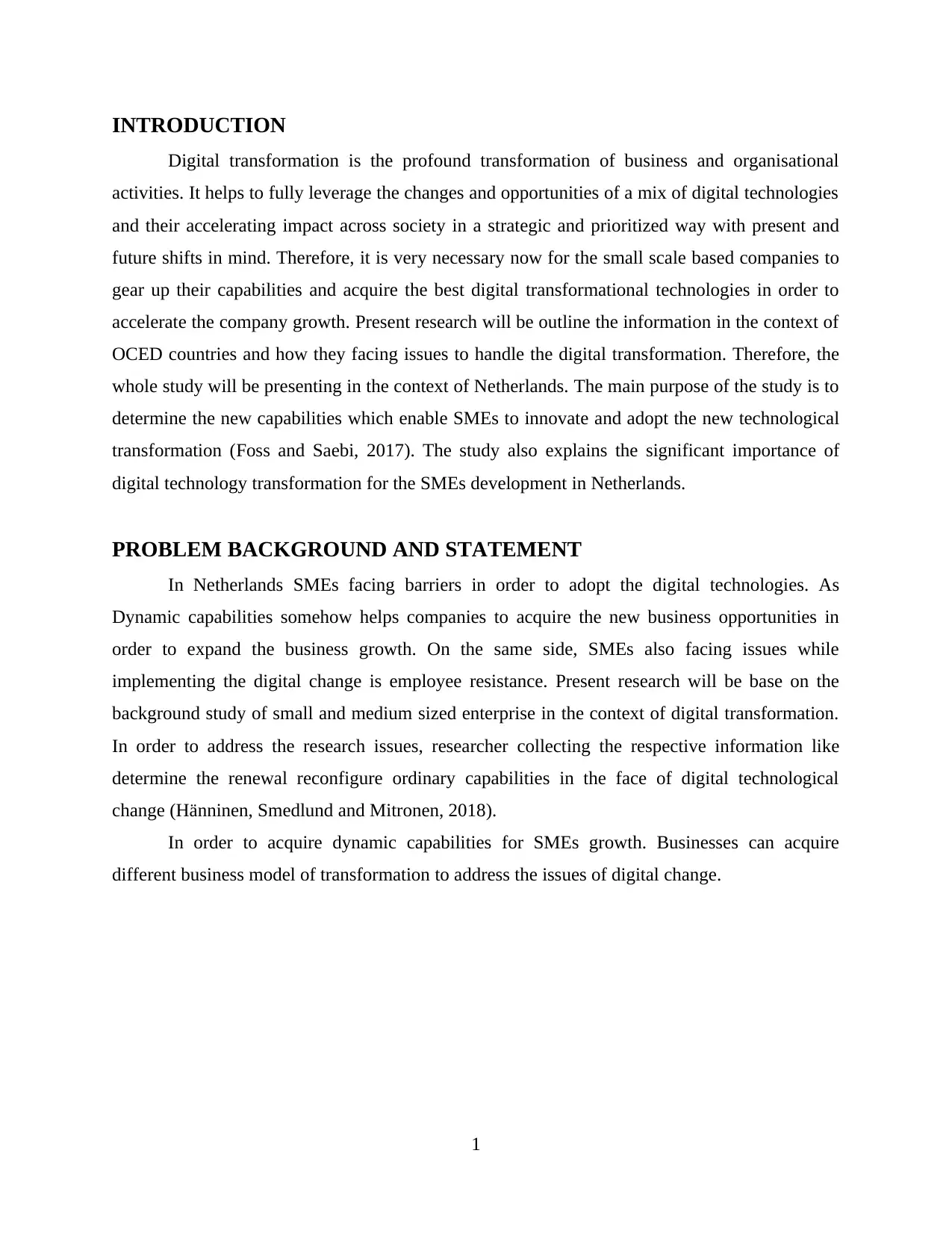
INTRODUCTION
Digital transformation is the profound transformation of business and organisational
activities. It helps to fully leverage the changes and opportunities of a mix of digital technologies
and their accelerating impact across society in a strategic and prioritized way with present and
future shifts in mind. Therefore, it is very necessary now for the small scale based companies to
gear up their capabilities and acquire the best digital transformational technologies in order to
accelerate the company growth. Present research will be outline the information in the context of
OCED countries and how they facing issues to handle the digital transformation. Therefore, the
whole study will be presenting in the context of Netherlands. The main purpose of the study is to
determine the new capabilities which enable SMEs to innovate and adopt the new technological
transformation (Foss and Saebi, 2017). The study also explains the significant importance of
digital technology transformation for the SMEs development in Netherlands.
PROBLEM BACKGROUND AND STATEMENT
In Netherlands SMEs facing barriers in order to adopt the digital technologies. As
Dynamic capabilities somehow helps companies to acquire the new business opportunities in
order to expand the business growth. On the same side, SMEs also facing issues while
implementing the digital change is employee resistance. Present research will be base on the
background study of small and medium sized enterprise in the context of digital transformation.
In order to address the research issues, researcher collecting the respective information like
determine the renewal reconfigure ordinary capabilities in the face of digital technological
change (Hänninen, Smedlund and Mitronen, 2018).
In order to acquire dynamic capabilities for SMEs growth. Businesses can acquire
different business model of transformation to address the issues of digital change.
1
Digital transformation is the profound transformation of business and organisational
activities. It helps to fully leverage the changes and opportunities of a mix of digital technologies
and their accelerating impact across society in a strategic and prioritized way with present and
future shifts in mind. Therefore, it is very necessary now for the small scale based companies to
gear up their capabilities and acquire the best digital transformational technologies in order to
accelerate the company growth. Present research will be outline the information in the context of
OCED countries and how they facing issues to handle the digital transformation. Therefore, the
whole study will be presenting in the context of Netherlands. The main purpose of the study is to
determine the new capabilities which enable SMEs to innovate and adopt the new technological
transformation (Foss and Saebi, 2017). The study also explains the significant importance of
digital technology transformation for the SMEs development in Netherlands.
PROBLEM BACKGROUND AND STATEMENT
In Netherlands SMEs facing barriers in order to adopt the digital technologies. As
Dynamic capabilities somehow helps companies to acquire the new business opportunities in
order to expand the business growth. On the same side, SMEs also facing issues while
implementing the digital change is employee resistance. Present research will be base on the
background study of small and medium sized enterprise in the context of digital transformation.
In order to address the research issues, researcher collecting the respective information like
determine the renewal reconfigure ordinary capabilities in the face of digital technological
change (Hänninen, Smedlund and Mitronen, 2018).
In order to acquire dynamic capabilities for SMEs growth. Businesses can acquire
different business model of transformation to address the issues of digital change.
1
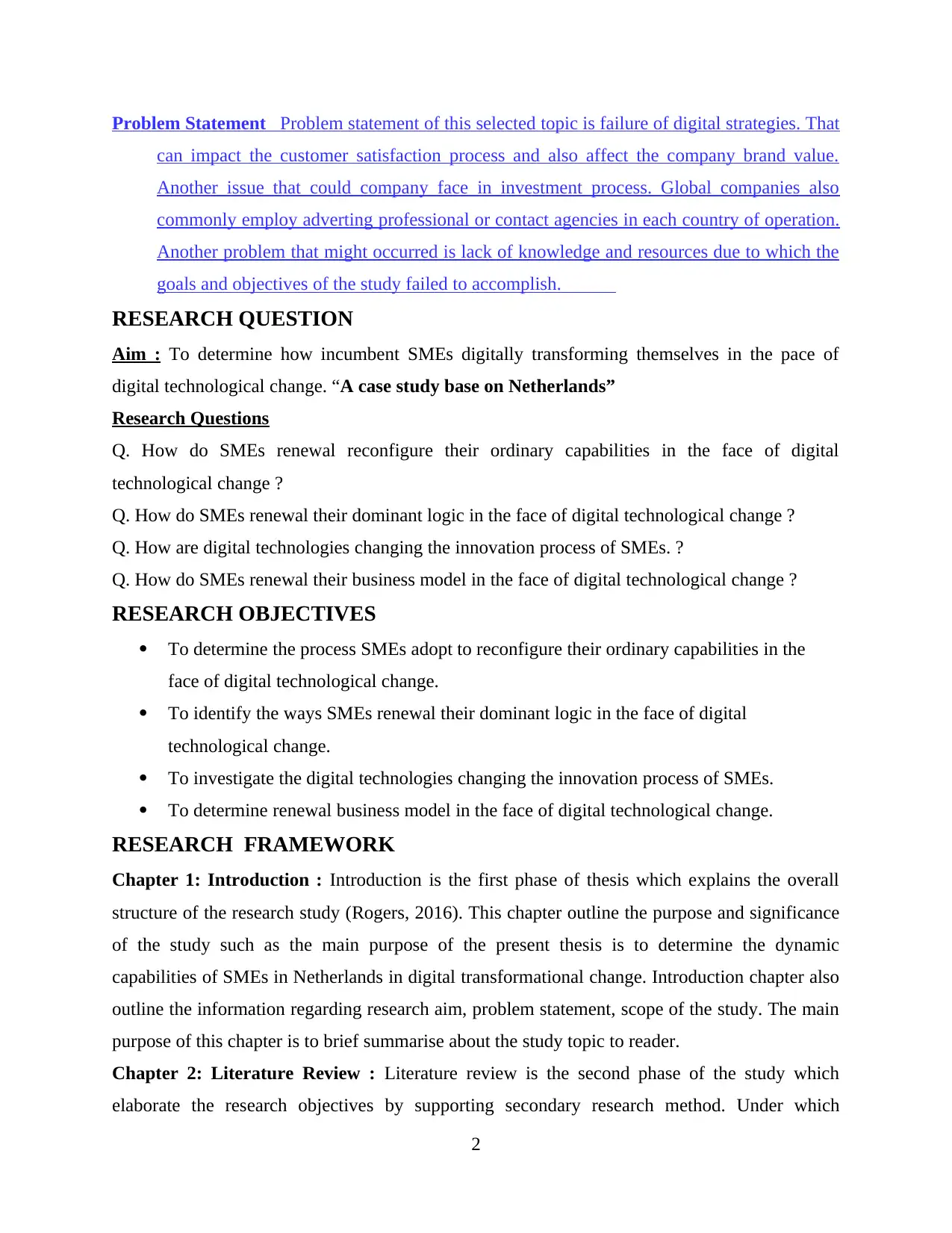
Problem Statement Problem statement of this selected topic is failure of digital strategies. That
can impact the customer satisfaction process and also affect the company brand value.
Another issue that could company face in investment process. Global companies also
commonly employ adverting professional or contact agencies in each country of operation.
Another problem that might occurred is lack of knowledge and resources due to which the
goals and objectives of the study failed to accomplish.
RESEARCH QUESTION
Aim : To determine how incumbent SMEs digitally transforming themselves in the pace of
digital technological change. “A case study base on Netherlands”
Research Questions
Q. How do SMEs renewal reconfigure their ordinary capabilities in the face of digital
technological change ?
Q. How do SMEs renewal their dominant logic in the face of digital technological change ?
Q. How are digital technologies changing the innovation process of SMEs. ?
Q. How do SMEs renewal their business model in the face of digital technological change ?
RESEARCH OBJECTIVES
To determine the process SMEs adopt to reconfigure their ordinary capabilities in the
face of digital technological change.
To identify the ways SMEs renewal their dominant logic in the face of digital
technological change.
To investigate the digital technologies changing the innovation process of SMEs.
To determine renewal business model in the face of digital technological change.
RESEARCH FRAMEWORK
Chapter 1: Introduction : Introduction is the first phase of thesis which explains the overall
structure of the research study (Rogers, 2016). This chapter outline the purpose and significance
of the study such as the main purpose of the present thesis is to determine the dynamic
capabilities of SMEs in Netherlands in digital transformational change. Introduction chapter also
outline the information regarding research aim, problem statement, scope of the study. The main
purpose of this chapter is to brief summarise about the study topic to reader.
Chapter 2: Literature Review : Literature review is the second phase of the study which
elaborate the research objectives by supporting secondary research method. Under which
2
can impact the customer satisfaction process and also affect the company brand value.
Another issue that could company face in investment process. Global companies also
commonly employ adverting professional or contact agencies in each country of operation.
Another problem that might occurred is lack of knowledge and resources due to which the
goals and objectives of the study failed to accomplish.
RESEARCH QUESTION
Aim : To determine how incumbent SMEs digitally transforming themselves in the pace of
digital technological change. “A case study base on Netherlands”
Research Questions
Q. How do SMEs renewal reconfigure their ordinary capabilities in the face of digital
technological change ?
Q. How do SMEs renewal their dominant logic in the face of digital technological change ?
Q. How are digital technologies changing the innovation process of SMEs. ?
Q. How do SMEs renewal their business model in the face of digital technological change ?
RESEARCH OBJECTIVES
To determine the process SMEs adopt to reconfigure their ordinary capabilities in the
face of digital technological change.
To identify the ways SMEs renewal their dominant logic in the face of digital
technological change.
To investigate the digital technologies changing the innovation process of SMEs.
To determine renewal business model in the face of digital technological change.
RESEARCH FRAMEWORK
Chapter 1: Introduction : Introduction is the first phase of thesis which explains the overall
structure of the research study (Rogers, 2016). This chapter outline the purpose and significance
of the study such as the main purpose of the present thesis is to determine the dynamic
capabilities of SMEs in Netherlands in digital transformational change. Introduction chapter also
outline the information regarding research aim, problem statement, scope of the study. The main
purpose of this chapter is to brief summarise about the study topic to reader.
Chapter 2: Literature Review : Literature review is the second phase of the study which
elaborate the research objectives by supporting secondary research method. Under which
2
Secure Best Marks with AI Grader
Need help grading? Try our AI Grader for instant feedback on your assignments.
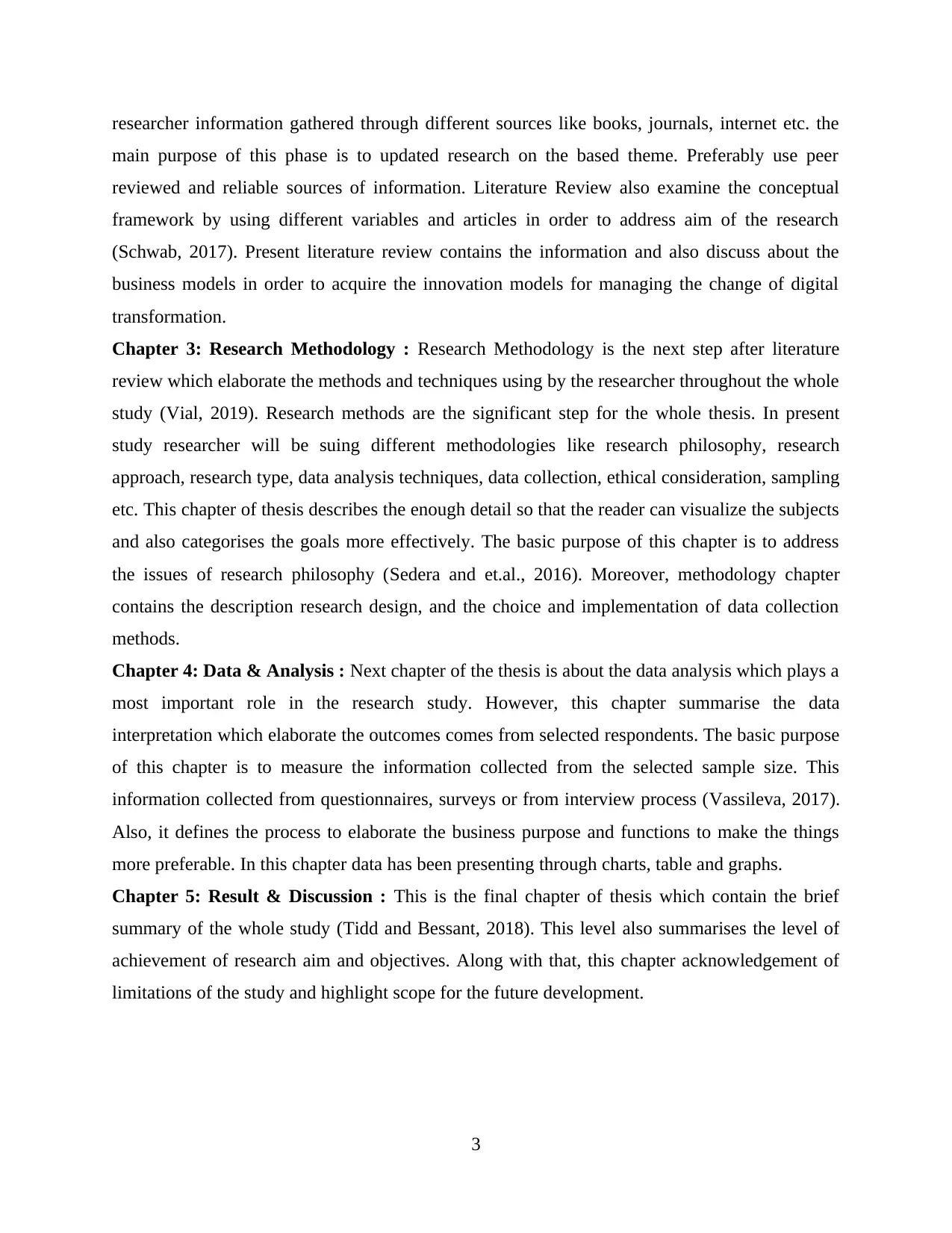
researcher information gathered through different sources like books, journals, internet etc. the
main purpose of this phase is to updated research on the based theme. Preferably use peer
reviewed and reliable sources of information. Literature Review also examine the conceptual
framework by using different variables and articles in order to address aim of the research
(Schwab, 2017). Present literature review contains the information and also discuss about the
business models in order to acquire the innovation models for managing the change of digital
transformation.
Chapter 3: Research Methodology : Research Methodology is the next step after literature
review which elaborate the methods and techniques using by the researcher throughout the whole
study (Vial, 2019). Research methods are the significant step for the whole thesis. In present
study researcher will be suing different methodologies like research philosophy, research
approach, research type, data analysis techniques, data collection, ethical consideration, sampling
etc. This chapter of thesis describes the enough detail so that the reader can visualize the subjects
and also categorises the goals more effectively. The basic purpose of this chapter is to address
the issues of research philosophy (Sedera and et.al., 2016). Moreover, methodology chapter
contains the description research design, and the choice and implementation of data collection
methods.
Chapter 4: Data & Analysis : Next chapter of the thesis is about the data analysis which plays a
most important role in the research study. However, this chapter summarise the data
interpretation which elaborate the outcomes comes from selected respondents. The basic purpose
of this chapter is to measure the information collected from the selected sample size. This
information collected from questionnaires, surveys or from interview process (Vassileva, 2017).
Also, it defines the process to elaborate the business purpose and functions to make the things
more preferable. In this chapter data has been presenting through charts, table and graphs.
Chapter 5: Result & Discussion : This is the final chapter of thesis which contain the brief
summary of the whole study (Tidd and Bessant, 2018). This level also summarises the level of
achievement of research aim and objectives. Along with that, this chapter acknowledgement of
limitations of the study and highlight scope for the future development.
3
main purpose of this phase is to updated research on the based theme. Preferably use peer
reviewed and reliable sources of information. Literature Review also examine the conceptual
framework by using different variables and articles in order to address aim of the research
(Schwab, 2017). Present literature review contains the information and also discuss about the
business models in order to acquire the innovation models for managing the change of digital
transformation.
Chapter 3: Research Methodology : Research Methodology is the next step after literature
review which elaborate the methods and techniques using by the researcher throughout the whole
study (Vial, 2019). Research methods are the significant step for the whole thesis. In present
study researcher will be suing different methodologies like research philosophy, research
approach, research type, data analysis techniques, data collection, ethical consideration, sampling
etc. This chapter of thesis describes the enough detail so that the reader can visualize the subjects
and also categorises the goals more effectively. The basic purpose of this chapter is to address
the issues of research philosophy (Sedera and et.al., 2016). Moreover, methodology chapter
contains the description research design, and the choice and implementation of data collection
methods.
Chapter 4: Data & Analysis : Next chapter of the thesis is about the data analysis which plays a
most important role in the research study. However, this chapter summarise the data
interpretation which elaborate the outcomes comes from selected respondents. The basic purpose
of this chapter is to measure the information collected from the selected sample size. This
information collected from questionnaires, surveys or from interview process (Vassileva, 2017).
Also, it defines the process to elaborate the business purpose and functions to make the things
more preferable. In this chapter data has been presenting through charts, table and graphs.
Chapter 5: Result & Discussion : This is the final chapter of thesis which contain the brief
summary of the whole study (Tidd and Bessant, 2018). This level also summarises the level of
achievement of research aim and objectives. Along with that, this chapter acknowledgement of
limitations of the study and highlight scope for the future development.
3
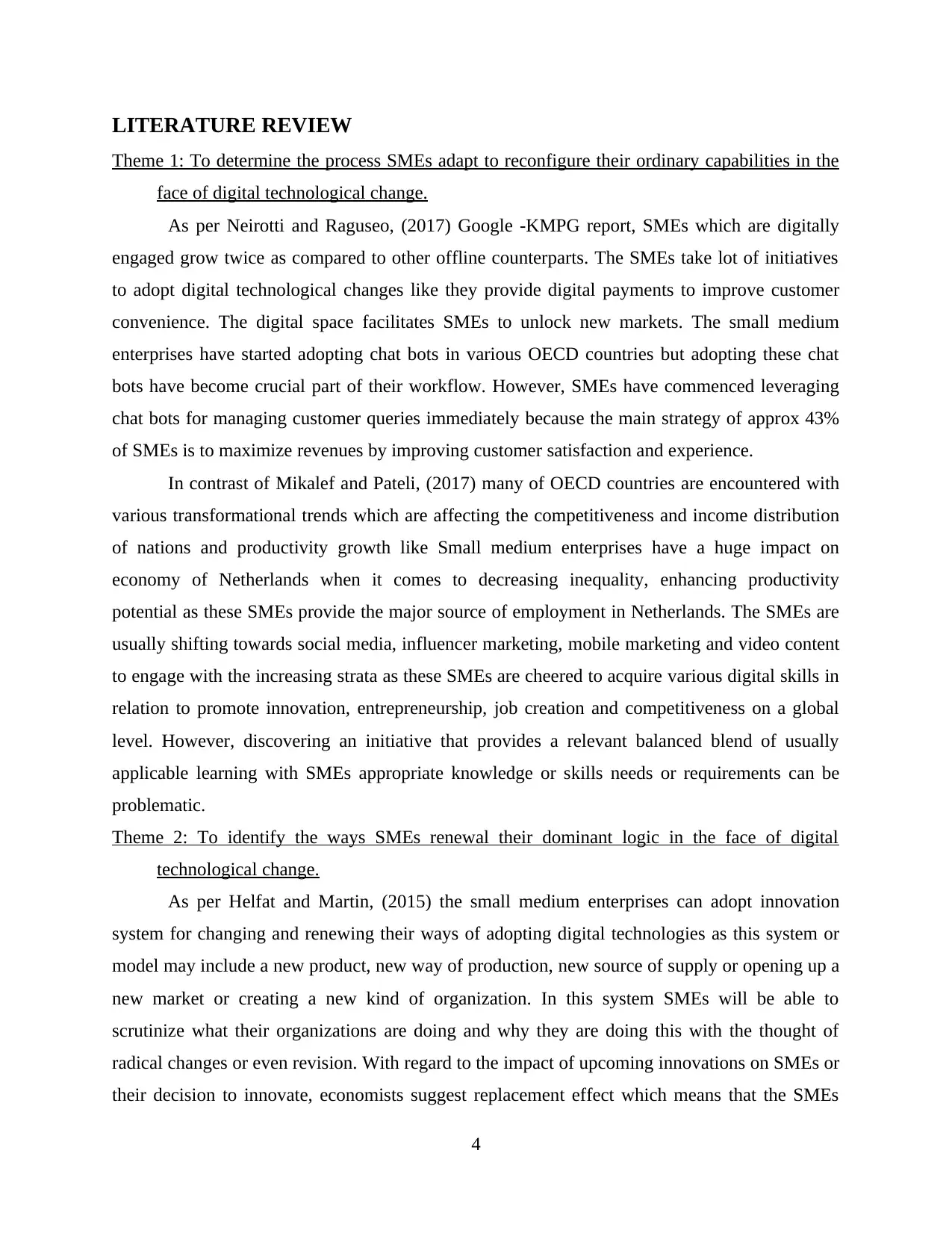
LITERATURE REVIEW
Theme 1: To determine the process SMEs adapt to reconfigure their ordinary capabilities in the
face of digital technological change.
As per Neirotti and Raguseo, (2017) Google -KMPG report, SMEs which are digitally
engaged grow twice as compared to other offline counterparts. The SMEs take lot of initiatives
to adopt digital technological changes like they provide digital payments to improve customer
convenience. The digital space facilitates SMEs to unlock new markets. The small medium
enterprises have started adopting chat bots in various OECD countries but adopting these chat
bots have become crucial part of their workflow. However, SMEs have commenced leveraging
chat bots for managing customer queries immediately because the main strategy of approx 43%
of SMEs is to maximize revenues by improving customer satisfaction and experience.
In contrast of Mikalef and Pateli, (2017) many of OECD countries are encountered with
various transformational trends which are affecting the competitiveness and income distribution
of nations and productivity growth like Small medium enterprises have a huge impact on
economy of Netherlands when it comes to decreasing inequality, enhancing productivity
potential as these SMEs provide the major source of employment in Netherlands. The SMEs are
usually shifting towards social media, influencer marketing, mobile marketing and video content
to engage with the increasing strata as these SMEs are cheered to acquire various digital skills in
relation to promote innovation, entrepreneurship, job creation and competitiveness on a global
level. However, discovering an initiative that provides a relevant balanced blend of usually
applicable learning with SMEs appropriate knowledge or skills needs or requirements can be
problematic.
Theme 2: To identify the ways SMEs renewal their dominant logic in the face of digital
technological change.
As per Helfat and Martin, (2015) the small medium enterprises can adopt innovation
system for changing and renewing their ways of adopting digital technologies as this system or
model may include a new product, new way of production, new source of supply or opening up a
new market or creating a new kind of organization. In this system SMEs will be able to
scrutinize what their organizations are doing and why they are doing this with the thought of
radical changes or even revision. With regard to the impact of upcoming innovations on SMEs or
their decision to innovate, economists suggest replacement effect which means that the SMEs
4
Theme 1: To determine the process SMEs adapt to reconfigure their ordinary capabilities in the
face of digital technological change.
As per Neirotti and Raguseo, (2017) Google -KMPG report, SMEs which are digitally
engaged grow twice as compared to other offline counterparts. The SMEs take lot of initiatives
to adopt digital technological changes like they provide digital payments to improve customer
convenience. The digital space facilitates SMEs to unlock new markets. The small medium
enterprises have started adopting chat bots in various OECD countries but adopting these chat
bots have become crucial part of their workflow. However, SMEs have commenced leveraging
chat bots for managing customer queries immediately because the main strategy of approx 43%
of SMEs is to maximize revenues by improving customer satisfaction and experience.
In contrast of Mikalef and Pateli, (2017) many of OECD countries are encountered with
various transformational trends which are affecting the competitiveness and income distribution
of nations and productivity growth like Small medium enterprises have a huge impact on
economy of Netherlands when it comes to decreasing inequality, enhancing productivity
potential as these SMEs provide the major source of employment in Netherlands. The SMEs are
usually shifting towards social media, influencer marketing, mobile marketing and video content
to engage with the increasing strata as these SMEs are cheered to acquire various digital skills in
relation to promote innovation, entrepreneurship, job creation and competitiveness on a global
level. However, discovering an initiative that provides a relevant balanced blend of usually
applicable learning with SMEs appropriate knowledge or skills needs or requirements can be
problematic.
Theme 2: To identify the ways SMEs renewal their dominant logic in the face of digital
technological change.
As per Helfat and Martin, (2015) the small medium enterprises can adopt innovation
system for changing and renewing their ways of adopting digital technologies as this system or
model may include a new product, new way of production, new source of supply or opening up a
new market or creating a new kind of organization. In this system SMEs will be able to
scrutinize what their organizations are doing and why they are doing this with the thought of
radical changes or even revision. With regard to the impact of upcoming innovations on SMEs or
their decision to innovate, economists suggest replacement effect which means that the SMEs
4
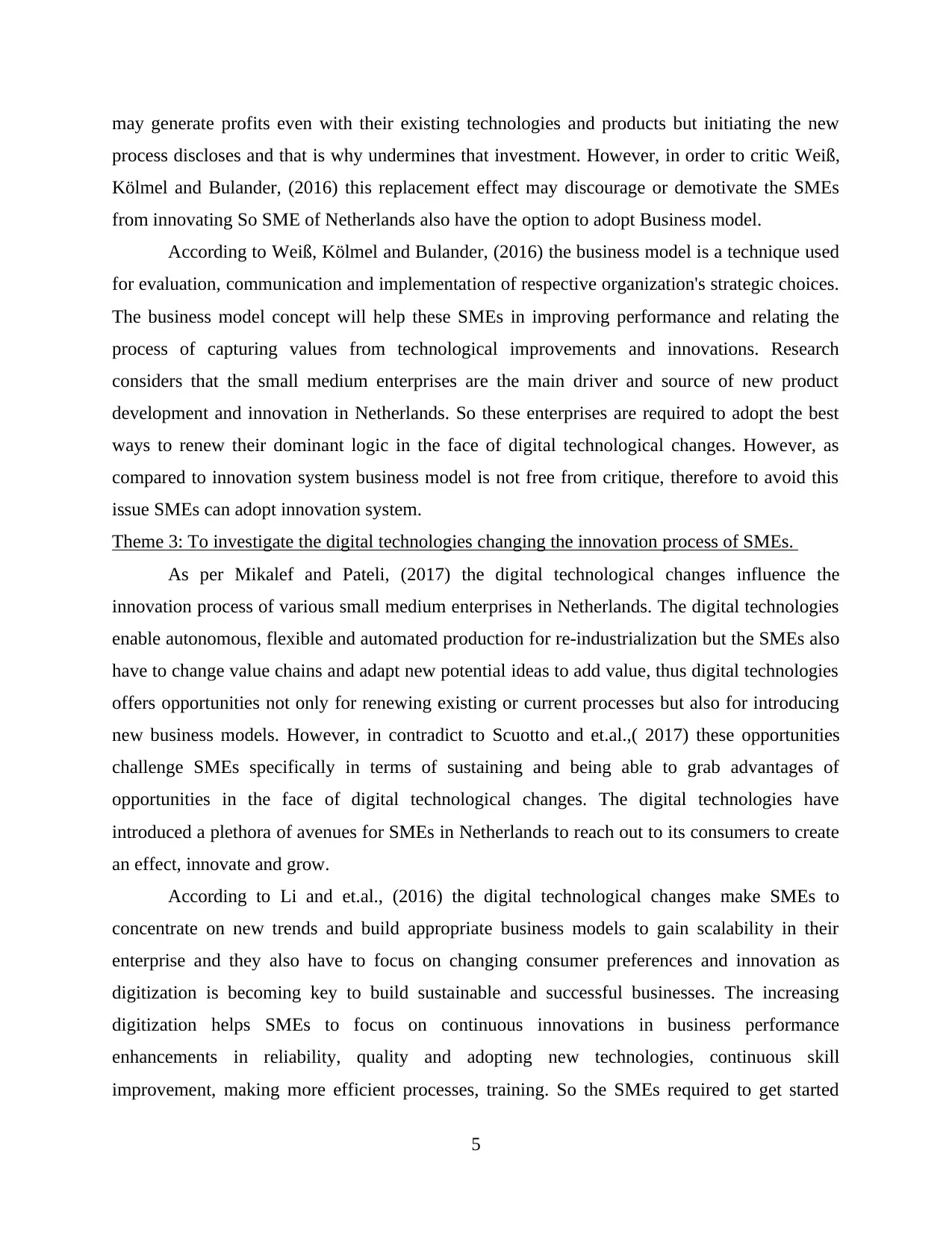
may generate profits even with their existing technologies and products but initiating the new
process discloses and that is why undermines that investment. However, in order to critic Weiß,
Kölmel and Bulander, (2016) this replacement effect may discourage or demotivate the SMEs
from innovating So SME of Netherlands also have the option to adopt Business model.
According to Weiß, Kölmel and Bulander, (2016) the business model is a technique used
for evaluation, communication and implementation of respective organization's strategic choices.
The business model concept will help these SMEs in improving performance and relating the
process of capturing values from technological improvements and innovations. Research
considers that the small medium enterprises are the main driver and source of new product
development and innovation in Netherlands. So these enterprises are required to adopt the best
ways to renew their dominant logic in the face of digital technological changes. However, as
compared to innovation system business model is not free from critique, therefore to avoid this
issue SMEs can adopt innovation system.
Theme 3: To investigate the digital technologies changing the innovation process of SMEs.
As per Mikalef and Pateli, (2017) the digital technological changes influence the
innovation process of various small medium enterprises in Netherlands. The digital technologies
enable autonomous, flexible and automated production for re-industrialization but the SMEs also
have to change value chains and adapt new potential ideas to add value, thus digital technologies
offers opportunities not only for renewing existing or current processes but also for introducing
new business models. However, in contradict to Scuotto and et.al.,( 2017) these opportunities
challenge SMEs specifically in terms of sustaining and being able to grab advantages of
opportunities in the face of digital technological changes. The digital technologies have
introduced a plethora of avenues for SMEs in Netherlands to reach out to its consumers to create
an effect, innovate and grow.
According to Li and et.al., (2016) the digital technological changes make SMEs to
concentrate on new trends and build appropriate business models to gain scalability in their
enterprise and they also have to focus on changing consumer preferences and innovation as
digitization is becoming key to build sustainable and successful businesses. The increasing
digitization helps SMEs to focus on continuous innovations in business performance
enhancements in reliability, quality and adopting new technologies, continuous skill
improvement, making more efficient processes, training. So the SMEs required to get started
5
process discloses and that is why undermines that investment. However, in order to critic Weiß,
Kölmel and Bulander, (2016) this replacement effect may discourage or demotivate the SMEs
from innovating So SME of Netherlands also have the option to adopt Business model.
According to Weiß, Kölmel and Bulander, (2016) the business model is a technique used
for evaluation, communication and implementation of respective organization's strategic choices.
The business model concept will help these SMEs in improving performance and relating the
process of capturing values from technological improvements and innovations. Research
considers that the small medium enterprises are the main driver and source of new product
development and innovation in Netherlands. So these enterprises are required to adopt the best
ways to renew their dominant logic in the face of digital technological changes. However, as
compared to innovation system business model is not free from critique, therefore to avoid this
issue SMEs can adopt innovation system.
Theme 3: To investigate the digital technologies changing the innovation process of SMEs.
As per Mikalef and Pateli, (2017) the digital technological changes influence the
innovation process of various small medium enterprises in Netherlands. The digital technologies
enable autonomous, flexible and automated production for re-industrialization but the SMEs also
have to change value chains and adapt new potential ideas to add value, thus digital technologies
offers opportunities not only for renewing existing or current processes but also for introducing
new business models. However, in contradict to Scuotto and et.al.,( 2017) these opportunities
challenge SMEs specifically in terms of sustaining and being able to grab advantages of
opportunities in the face of digital technological changes. The digital technologies have
introduced a plethora of avenues for SMEs in Netherlands to reach out to its consumers to create
an effect, innovate and grow.
According to Li and et.al., (2016) the digital technological changes make SMEs to
concentrate on new trends and build appropriate business models to gain scalability in their
enterprise and they also have to focus on changing consumer preferences and innovation as
digitization is becoming key to build sustainable and successful businesses. The increasing
digitization helps SMEs to focus on continuous innovations in business performance
enhancements in reliability, quality and adopting new technologies, continuous skill
improvement, making more efficient processes, training. So the SMEs required to get started
5
Paraphrase This Document
Need a fresh take? Get an instant paraphrase of this document with our AI Paraphraser
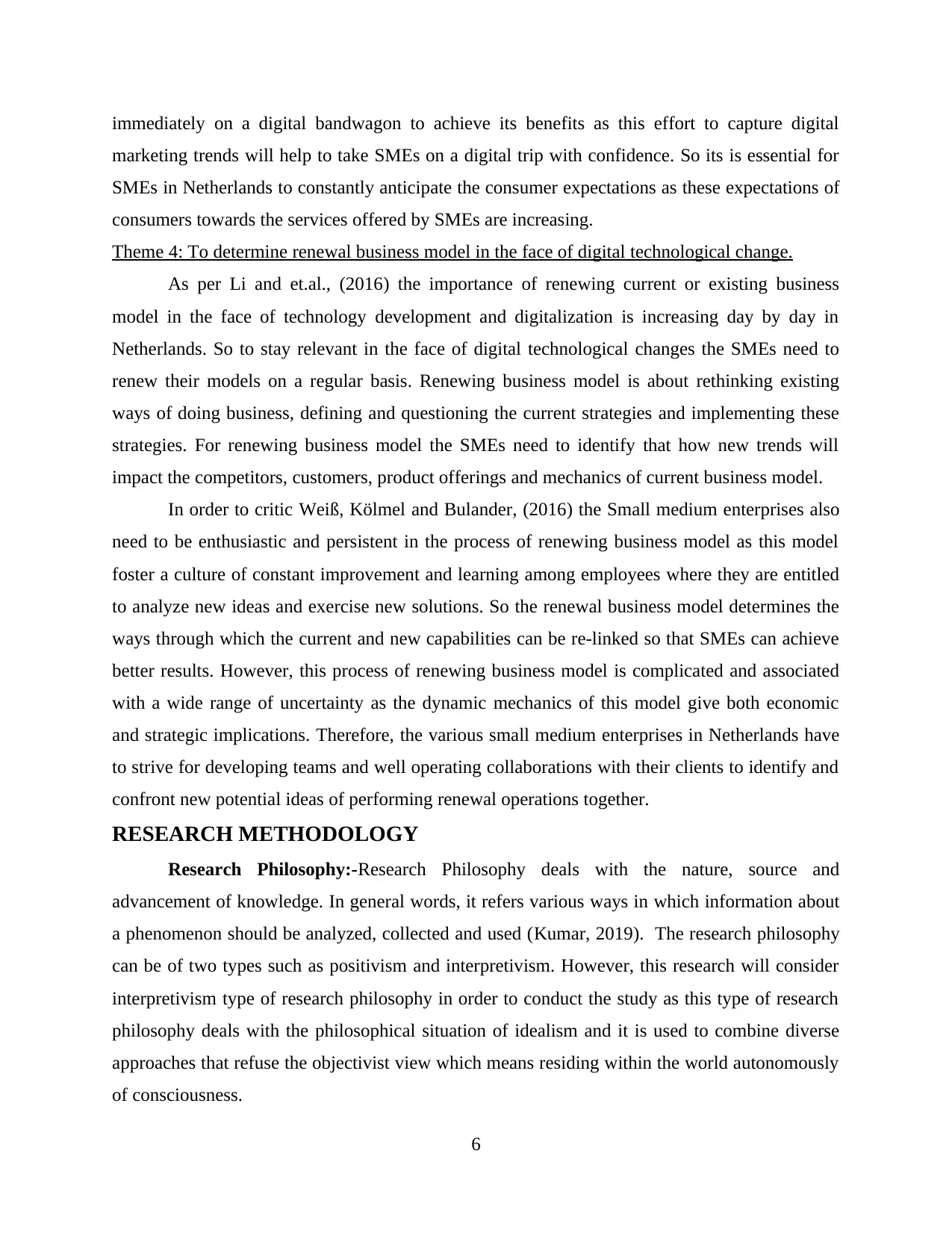
immediately on a digital bandwagon to achieve its benefits as this effort to capture digital
marketing trends will help to take SMEs on a digital trip with confidence. So its is essential for
SMEs in Netherlands to constantly anticipate the consumer expectations as these expectations of
consumers towards the services offered by SMEs are increasing.
Theme 4: To determine renewal business model in the face of digital technological change.
As per Li and et.al., (2016) the importance of renewing current or existing business
model in the face of technology development and digitalization is increasing day by day in
Netherlands. So to stay relevant in the face of digital technological changes the SMEs need to
renew their models on a regular basis. Renewing business model is about rethinking existing
ways of doing business, defining and questioning the current strategies and implementing these
strategies. For renewing business model the SMEs need to identify that how new trends will
impact the competitors, customers, product offerings and mechanics of current business model.
In order to critic Weiß, Kölmel and Bulander, (2016) the Small medium enterprises also
need to be enthusiastic and persistent in the process of renewing business model as this model
foster a culture of constant improvement and learning among employees where they are entitled
to analyze new ideas and exercise new solutions. So the renewal business model determines the
ways through which the current and new capabilities can be re-linked so that SMEs can achieve
better results. However, this process of renewing business model is complicated and associated
with a wide range of uncertainty as the dynamic mechanics of this model give both economic
and strategic implications. Therefore, the various small medium enterprises in Netherlands have
to strive for developing teams and well operating collaborations with their clients to identify and
confront new potential ideas of performing renewal operations together.
RESEARCH METHODOLOGY
Research Philosophy:-Research Philosophy deals with the nature, source and
advancement of knowledge. In general words, it refers various ways in which information about
a phenomenon should be analyzed, collected and used (Kumar, 2019). The research philosophy
can be of two types such as positivism and interpretivism. However, this research will consider
interpretivism type of research philosophy in order to conduct the study as this type of research
philosophy deals with the philosophical situation of idealism and it is used to combine diverse
approaches that refuse the objectivist view which means residing within the world autonomously
of consciousness.
6
marketing trends will help to take SMEs on a digital trip with confidence. So its is essential for
SMEs in Netherlands to constantly anticipate the consumer expectations as these expectations of
consumers towards the services offered by SMEs are increasing.
Theme 4: To determine renewal business model in the face of digital technological change.
As per Li and et.al., (2016) the importance of renewing current or existing business
model in the face of technology development and digitalization is increasing day by day in
Netherlands. So to stay relevant in the face of digital technological changes the SMEs need to
renew their models on a regular basis. Renewing business model is about rethinking existing
ways of doing business, defining and questioning the current strategies and implementing these
strategies. For renewing business model the SMEs need to identify that how new trends will
impact the competitors, customers, product offerings and mechanics of current business model.
In order to critic Weiß, Kölmel and Bulander, (2016) the Small medium enterprises also
need to be enthusiastic and persistent in the process of renewing business model as this model
foster a culture of constant improvement and learning among employees where they are entitled
to analyze new ideas and exercise new solutions. So the renewal business model determines the
ways through which the current and new capabilities can be re-linked so that SMEs can achieve
better results. However, this process of renewing business model is complicated and associated
with a wide range of uncertainty as the dynamic mechanics of this model give both economic
and strategic implications. Therefore, the various small medium enterprises in Netherlands have
to strive for developing teams and well operating collaborations with their clients to identify and
confront new potential ideas of performing renewal operations together.
RESEARCH METHODOLOGY
Research Philosophy:-Research Philosophy deals with the nature, source and
advancement of knowledge. In general words, it refers various ways in which information about
a phenomenon should be analyzed, collected and used (Kumar, 2019). The research philosophy
can be of two types such as positivism and interpretivism. However, this research will consider
interpretivism type of research philosophy in order to conduct the study as this type of research
philosophy deals with the philosophical situation of idealism and it is used to combine diverse
approaches that refuse the objectivist view which means residing within the world autonomously
of consciousness.
6
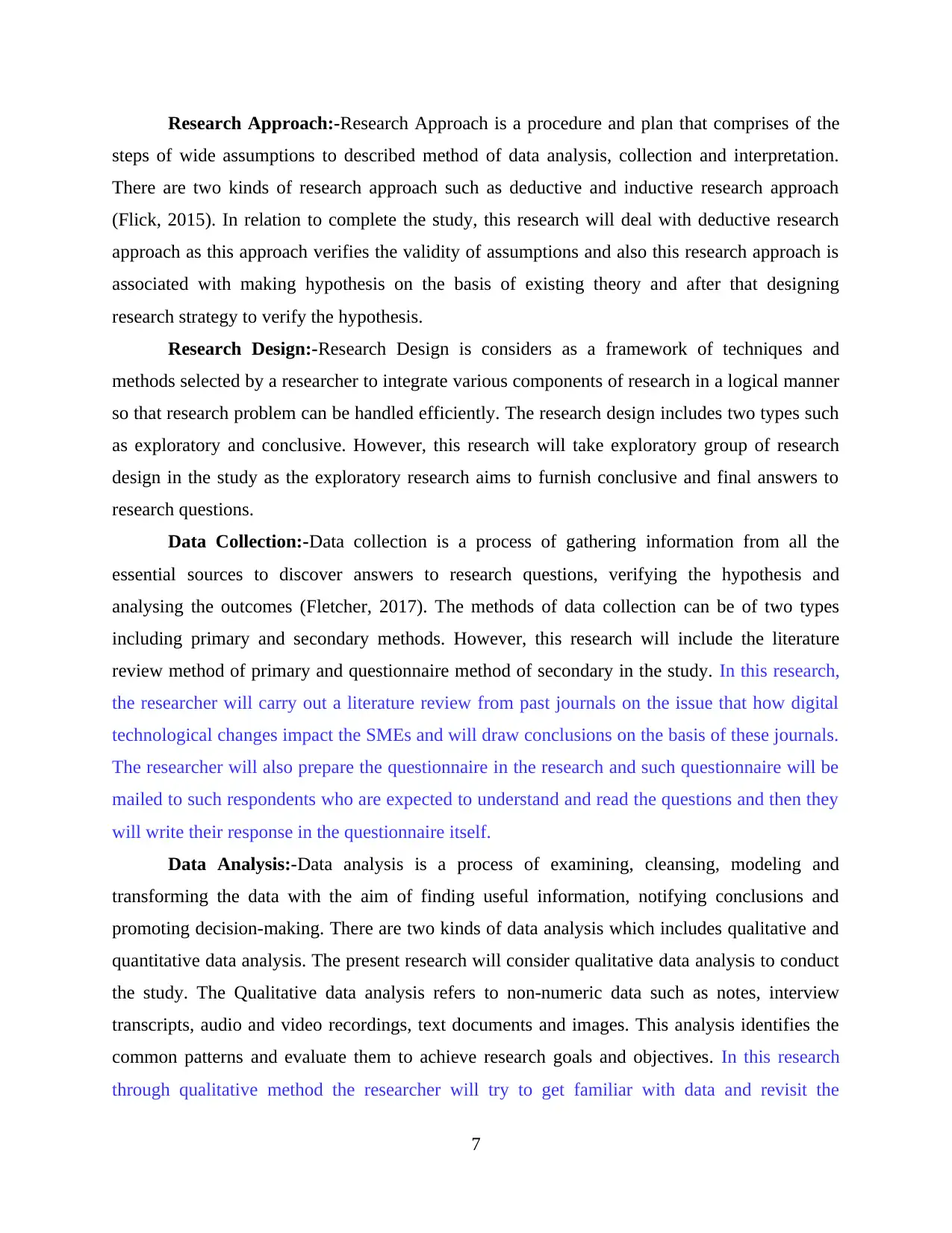
Research Approach:-Research Approach is a procedure and plan that comprises of the
steps of wide assumptions to described method of data analysis, collection and interpretation.
There are two kinds of research approach such as deductive and inductive research approach
(Flick, 2015). In relation to complete the study, this research will deal with deductive research
approach as this approach verifies the validity of assumptions and also this research approach is
associated with making hypothesis on the basis of existing theory and after that designing
research strategy to verify the hypothesis.
Research Design:-Research Design is considers as a framework of techniques and
methods selected by a researcher to integrate various components of research in a logical manner
so that research problem can be handled efficiently. The research design includes two types such
as exploratory and conclusive. However, this research will take exploratory group of research
design in the study as the exploratory research aims to furnish conclusive and final answers to
research questions.
Data Collection:-Data collection is a process of gathering information from all the
essential sources to discover answers to research questions, verifying the hypothesis and
analysing the outcomes (Fletcher, 2017). The methods of data collection can be of two types
including primary and secondary methods. However, this research will include the literature
review method of primary and questionnaire method of secondary in the study. In this research,
the researcher will carry out a literature review from past journals on the issue that how digital
technological changes impact the SMEs and will draw conclusions on the basis of these journals.
The researcher will also prepare the questionnaire in the research and such questionnaire will be
mailed to such respondents who are expected to understand and read the questions and then they
will write their response in the questionnaire itself.
Data Analysis:-Data analysis is a process of examining, cleansing, modeling and
transforming the data with the aim of finding useful information, notifying conclusions and
promoting decision-making. There are two kinds of data analysis which includes qualitative and
quantitative data analysis. The present research will consider qualitative data analysis to conduct
the study. The Qualitative data analysis refers to non-numeric data such as notes, interview
transcripts, audio and video recordings, text documents and images. This analysis identifies the
common patterns and evaluate them to achieve research goals and objectives. In this research
through qualitative method the researcher will try to get familiar with data and revisit the
7
steps of wide assumptions to described method of data analysis, collection and interpretation.
There are two kinds of research approach such as deductive and inductive research approach
(Flick, 2015). In relation to complete the study, this research will deal with deductive research
approach as this approach verifies the validity of assumptions and also this research approach is
associated with making hypothesis on the basis of existing theory and after that designing
research strategy to verify the hypothesis.
Research Design:-Research Design is considers as a framework of techniques and
methods selected by a researcher to integrate various components of research in a logical manner
so that research problem can be handled efficiently. The research design includes two types such
as exploratory and conclusive. However, this research will take exploratory group of research
design in the study as the exploratory research aims to furnish conclusive and final answers to
research questions.
Data Collection:-Data collection is a process of gathering information from all the
essential sources to discover answers to research questions, verifying the hypothesis and
analysing the outcomes (Fletcher, 2017). The methods of data collection can be of two types
including primary and secondary methods. However, this research will include the literature
review method of primary and questionnaire method of secondary in the study. In this research,
the researcher will carry out a literature review from past journals on the issue that how digital
technological changes impact the SMEs and will draw conclusions on the basis of these journals.
The researcher will also prepare the questionnaire in the research and such questionnaire will be
mailed to such respondents who are expected to understand and read the questions and then they
will write their response in the questionnaire itself.
Data Analysis:-Data analysis is a process of examining, cleansing, modeling and
transforming the data with the aim of finding useful information, notifying conclusions and
promoting decision-making. There are two kinds of data analysis which includes qualitative and
quantitative data analysis. The present research will consider qualitative data analysis to conduct
the study. The Qualitative data analysis refers to non-numeric data such as notes, interview
transcripts, audio and video recordings, text documents and images. This analysis identifies the
common patterns and evaluate them to achieve research goals and objectives. In this research
through qualitative method the researcher will try to get familiar with data and revisit the
7
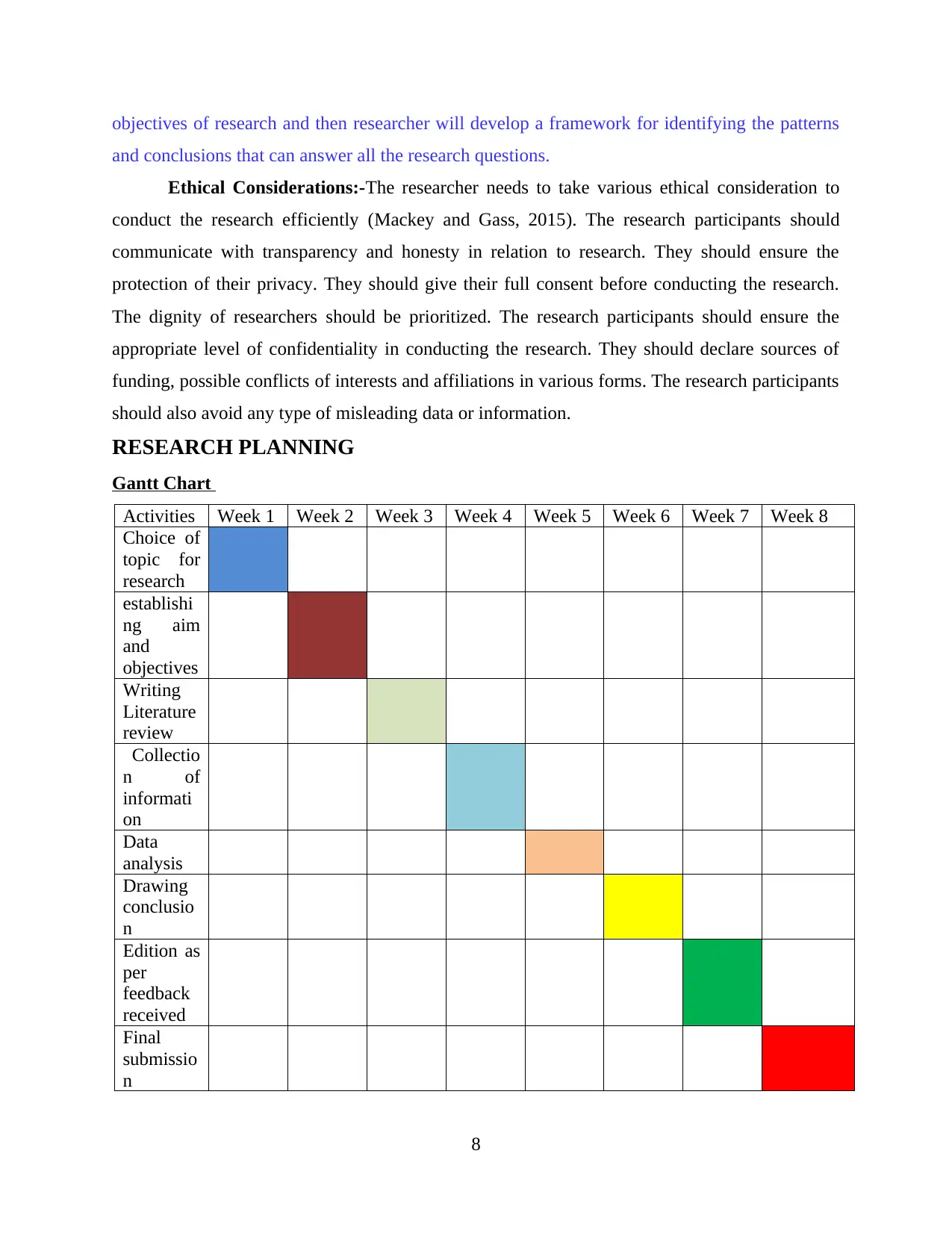
objectives of research and then researcher will develop a framework for identifying the patterns
and conclusions that can answer all the research questions.
Ethical Considerations:-The researcher needs to take various ethical consideration to
conduct the research efficiently (Mackey and Gass, 2015). The research participants should
communicate with transparency and honesty in relation to research. They should ensure the
protection of their privacy. They should give their full consent before conducting the research.
The dignity of researchers should be prioritized. The research participants should ensure the
appropriate level of confidentiality in conducting the research. They should declare sources of
funding, possible conflicts of interests and affiliations in various forms. The research participants
should also avoid any type of misleading data or information.
RESEARCH PLANNING
Gantt Chart
Activities Week 1 Week 2 Week 3 Week 4 Week 5 Week 6 Week 7 Week 8
Choice of
topic for
research
establishi
ng aim
and
objectives
Writing
Literature
review
Collectio
n of
informati
on
Data
analysis
Drawing
conclusio
n
Edition as
per
feedback
received
Final
submissio
n
8
and conclusions that can answer all the research questions.
Ethical Considerations:-The researcher needs to take various ethical consideration to
conduct the research efficiently (Mackey and Gass, 2015). The research participants should
communicate with transparency and honesty in relation to research. They should ensure the
protection of their privacy. They should give their full consent before conducting the research.
The dignity of researchers should be prioritized. The research participants should ensure the
appropriate level of confidentiality in conducting the research. They should declare sources of
funding, possible conflicts of interests and affiliations in various forms. The research participants
should also avoid any type of misleading data or information.
RESEARCH PLANNING
Gantt Chart
Activities Week 1 Week 2 Week 3 Week 4 Week 5 Week 6 Week 7 Week 8
Choice of
topic for
research
establishi
ng aim
and
objectives
Writing
Literature
review
Collectio
n of
informati
on
Data
analysis
Drawing
conclusio
n
Edition as
per
feedback
received
Final
submissio
n
8
Secure Best Marks with AI Grader
Need help grading? Try our AI Grader for instant feedback on your assignments.
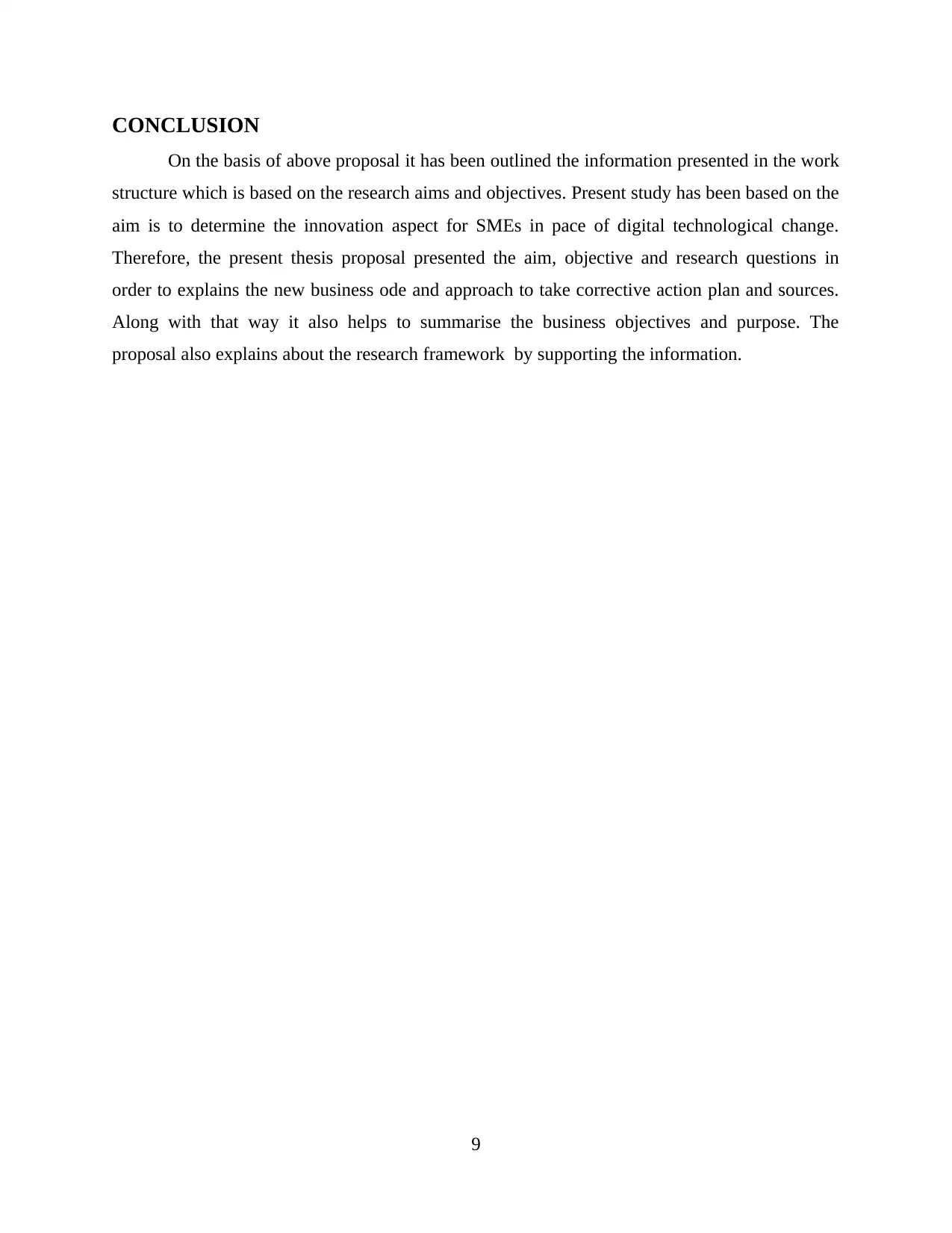
CONCLUSION
On the basis of above proposal it has been outlined the information presented in the work
structure which is based on the research aims and objectives. Present study has been based on the
aim is to determine the innovation aspect for SMEs in pace of digital technological change.
Therefore, the present thesis proposal presented the aim, objective and research questions in
order to explains the new business ode and approach to take corrective action plan and sources.
Along with that way it also helps to summarise the business objectives and purpose. The
proposal also explains about the research framework by supporting the information.
9
On the basis of above proposal it has been outlined the information presented in the work
structure which is based on the research aims and objectives. Present study has been based on the
aim is to determine the innovation aspect for SMEs in pace of digital technological change.
Therefore, the present thesis proposal presented the aim, objective and research questions in
order to explains the new business ode and approach to take corrective action plan and sources.
Along with that way it also helps to summarise the business objectives and purpose. The
proposal also explains about the research framework by supporting the information.
9
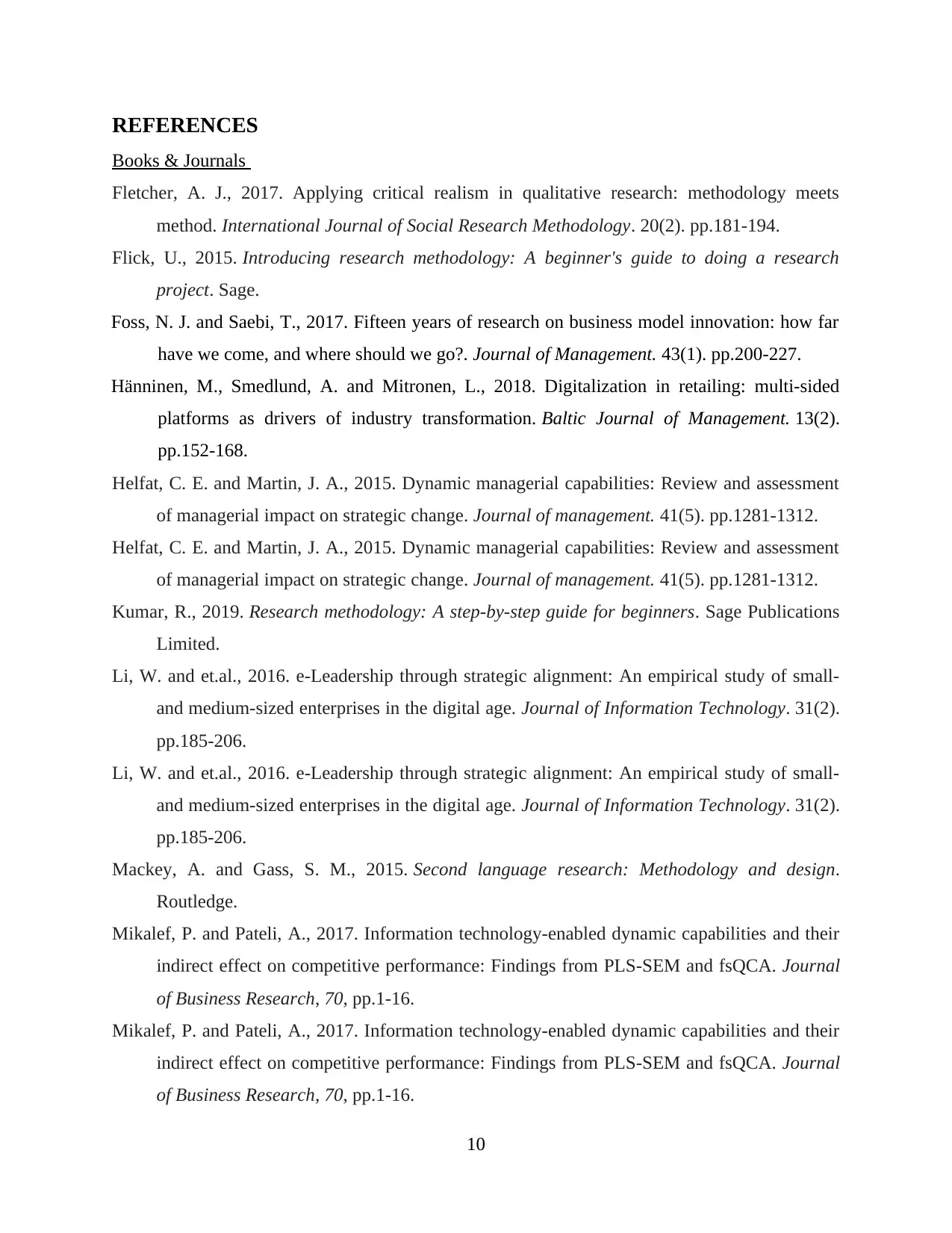
REFERENCES
Books & Journals
Fletcher, A. J., 2017. Applying critical realism in qualitative research: methodology meets
method. International Journal of Social Research Methodology. 20(2). pp.181-194.
Flick, U., 2015. Introducing research methodology: A beginner's guide to doing a research
project. Sage.
Foss, N. J. and Saebi, T., 2017. Fifteen years of research on business model innovation: how far
have we come, and where should we go?. Journal of Management. 43(1). pp.200-227.
Hänninen, M., Smedlund, A. and Mitronen, L., 2018. Digitalization in retailing: multi-sided
platforms as drivers of industry transformation. Baltic Journal of Management. 13(2).
pp.152-168.
Helfat, C. E. and Martin, J. A., 2015. Dynamic managerial capabilities: Review and assessment
of managerial impact on strategic change. Journal of management. 41(5). pp.1281-1312.
Helfat, C. E. and Martin, J. A., 2015. Dynamic managerial capabilities: Review and assessment
of managerial impact on strategic change. Journal of management. 41(5). pp.1281-1312.
Kumar, R., 2019. Research methodology: A step-by-step guide for beginners. Sage Publications
Limited.
Li, W. and et.al., 2016. e-Leadership through strategic alignment: An empirical study of small-
and medium-sized enterprises in the digital age. Journal of Information Technology. 31(2).
pp.185-206.
Li, W. and et.al., 2016. e-Leadership through strategic alignment: An empirical study of small-
and medium-sized enterprises in the digital age. Journal of Information Technology. 31(2).
pp.185-206.
Mackey, A. and Gass, S. M., 2015. Second language research: Methodology and design.
Routledge.
Mikalef, P. and Pateli, A., 2017. Information technology-enabled dynamic capabilities and their
indirect effect on competitive performance: Findings from PLS-SEM and fsQCA. Journal
of Business Research, 70, pp.1-16.
Mikalef, P. and Pateli, A., 2017. Information technology-enabled dynamic capabilities and their
indirect effect on competitive performance: Findings from PLS-SEM and fsQCA. Journal
of Business Research, 70, pp.1-16.
10
Books & Journals
Fletcher, A. J., 2017. Applying critical realism in qualitative research: methodology meets
method. International Journal of Social Research Methodology. 20(2). pp.181-194.
Flick, U., 2015. Introducing research methodology: A beginner's guide to doing a research
project. Sage.
Foss, N. J. and Saebi, T., 2017. Fifteen years of research on business model innovation: how far
have we come, and where should we go?. Journal of Management. 43(1). pp.200-227.
Hänninen, M., Smedlund, A. and Mitronen, L., 2018. Digitalization in retailing: multi-sided
platforms as drivers of industry transformation. Baltic Journal of Management. 13(2).
pp.152-168.
Helfat, C. E. and Martin, J. A., 2015. Dynamic managerial capabilities: Review and assessment
of managerial impact on strategic change. Journal of management. 41(5). pp.1281-1312.
Helfat, C. E. and Martin, J. A., 2015. Dynamic managerial capabilities: Review and assessment
of managerial impact on strategic change. Journal of management. 41(5). pp.1281-1312.
Kumar, R., 2019. Research methodology: A step-by-step guide for beginners. Sage Publications
Limited.
Li, W. and et.al., 2016. e-Leadership through strategic alignment: An empirical study of small-
and medium-sized enterprises in the digital age. Journal of Information Technology. 31(2).
pp.185-206.
Li, W. and et.al., 2016. e-Leadership through strategic alignment: An empirical study of small-
and medium-sized enterprises in the digital age. Journal of Information Technology. 31(2).
pp.185-206.
Mackey, A. and Gass, S. M., 2015. Second language research: Methodology and design.
Routledge.
Mikalef, P. and Pateli, A., 2017. Information technology-enabled dynamic capabilities and their
indirect effect on competitive performance: Findings from PLS-SEM and fsQCA. Journal
of Business Research, 70, pp.1-16.
Mikalef, P. and Pateli, A., 2017. Information technology-enabled dynamic capabilities and their
indirect effect on competitive performance: Findings from PLS-SEM and fsQCA. Journal
of Business Research, 70, pp.1-16.
10
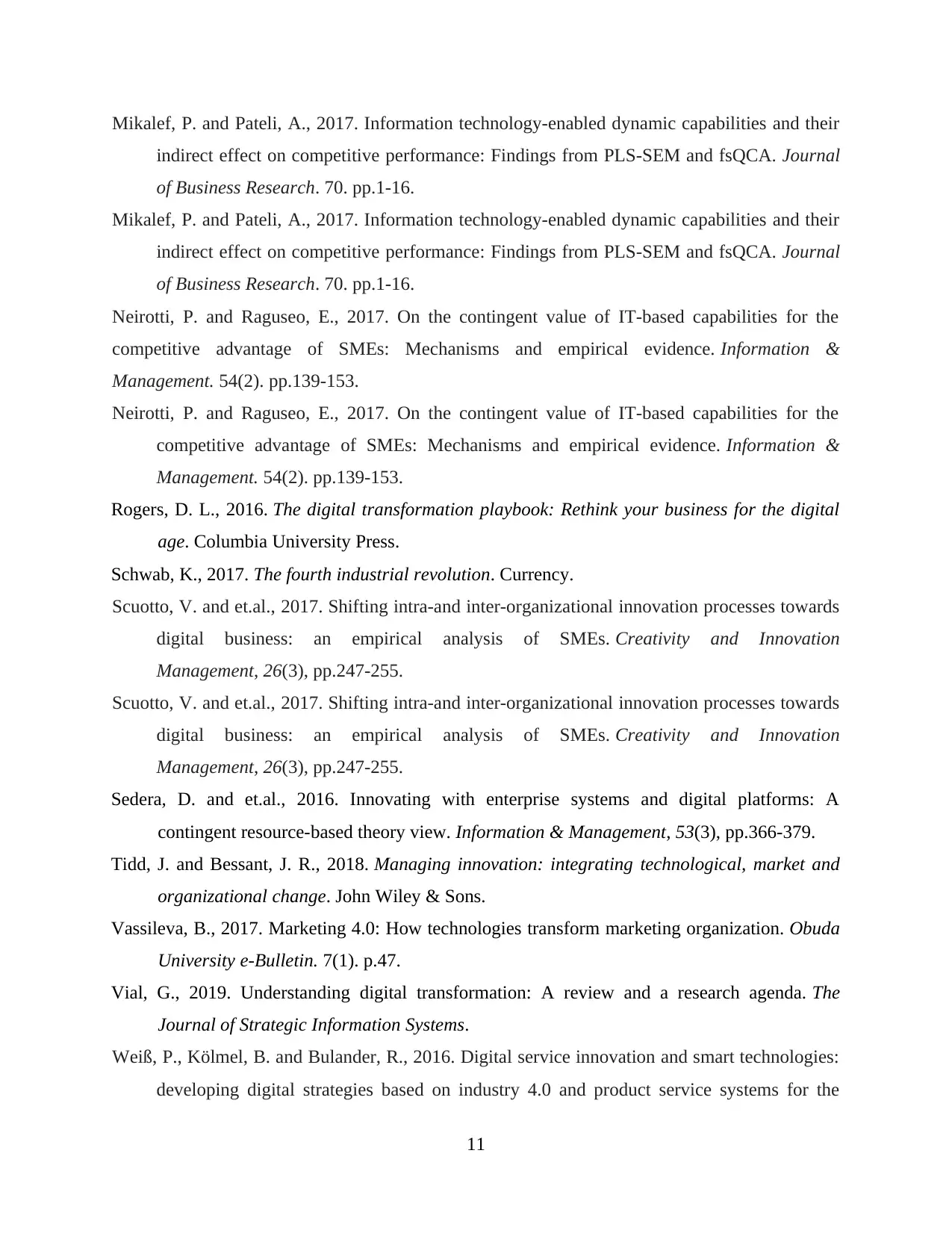
Mikalef, P. and Pateli, A., 2017. Information technology-enabled dynamic capabilities and their
indirect effect on competitive performance: Findings from PLS-SEM and fsQCA. Journal
of Business Research. 70. pp.1-16.
Mikalef, P. and Pateli, A., 2017. Information technology-enabled dynamic capabilities and their
indirect effect on competitive performance: Findings from PLS-SEM and fsQCA. Journal
of Business Research. 70. pp.1-16.
Neirotti, P. and Raguseo, E., 2017. On the contingent value of IT-based capabilities for the
competitive advantage of SMEs: Mechanisms and empirical evidence. Information &
Management. 54(2). pp.139-153.
Neirotti, P. and Raguseo, E., 2017. On the contingent value of IT-based capabilities for the
competitive advantage of SMEs: Mechanisms and empirical evidence. Information &
Management. 54(2). pp.139-153.
Rogers, D. L., 2016. The digital transformation playbook: Rethink your business for the digital
age. Columbia University Press.
Schwab, K., 2017. The fourth industrial revolution. Currency.
Scuotto, V. and et.al., 2017. Shifting intra‐and inter‐organizational innovation processes towards
digital business: an empirical analysis of SMEs. Creativity and Innovation
Management, 26(3), pp.247-255.
Scuotto, V. and et.al., 2017. Shifting intra‐and inter‐organizational innovation processes towards
digital business: an empirical analysis of SMEs. Creativity and Innovation
Management, 26(3), pp.247-255.
Sedera, D. and et.al., 2016. Innovating with enterprise systems and digital platforms: A
contingent resource-based theory view. Information & Management, 53(3), pp.366-379.
Tidd, J. and Bessant, J. R., 2018. Managing innovation: integrating technological, market and
organizational change. John Wiley & Sons.
Vassileva, B., 2017. Marketing 4.0: How technologies transform marketing organization. Obuda
University e-Bulletin. 7(1). p.47.
Vial, G., 2019. Understanding digital transformation: A review and a research agenda. The
Journal of Strategic Information Systems.
Weiß, P., Kölmel, B. and Bulander, R., 2016. Digital service innovation and smart technologies:
developing digital strategies based on industry 4.0 and product service systems for the
11
indirect effect on competitive performance: Findings from PLS-SEM and fsQCA. Journal
of Business Research. 70. pp.1-16.
Mikalef, P. and Pateli, A., 2017. Information technology-enabled dynamic capabilities and their
indirect effect on competitive performance: Findings from PLS-SEM and fsQCA. Journal
of Business Research. 70. pp.1-16.
Neirotti, P. and Raguseo, E., 2017. On the contingent value of IT-based capabilities for the
competitive advantage of SMEs: Mechanisms and empirical evidence. Information &
Management. 54(2). pp.139-153.
Neirotti, P. and Raguseo, E., 2017. On the contingent value of IT-based capabilities for the
competitive advantage of SMEs: Mechanisms and empirical evidence. Information &
Management. 54(2). pp.139-153.
Rogers, D. L., 2016. The digital transformation playbook: Rethink your business for the digital
age. Columbia University Press.
Schwab, K., 2017. The fourth industrial revolution. Currency.
Scuotto, V. and et.al., 2017. Shifting intra‐and inter‐organizational innovation processes towards
digital business: an empirical analysis of SMEs. Creativity and Innovation
Management, 26(3), pp.247-255.
Scuotto, V. and et.al., 2017. Shifting intra‐and inter‐organizational innovation processes towards
digital business: an empirical analysis of SMEs. Creativity and Innovation
Management, 26(3), pp.247-255.
Sedera, D. and et.al., 2016. Innovating with enterprise systems and digital platforms: A
contingent resource-based theory view. Information & Management, 53(3), pp.366-379.
Tidd, J. and Bessant, J. R., 2018. Managing innovation: integrating technological, market and
organizational change. John Wiley & Sons.
Vassileva, B., 2017. Marketing 4.0: How technologies transform marketing organization. Obuda
University e-Bulletin. 7(1). p.47.
Vial, G., 2019. Understanding digital transformation: A review and a research agenda. The
Journal of Strategic Information Systems.
Weiß, P., Kölmel, B. and Bulander, R., 2016. Digital service innovation and smart technologies:
developing digital strategies based on industry 4.0 and product service systems for the
11
Paraphrase This Document
Need a fresh take? Get an instant paraphrase of this document with our AI Paraphraser
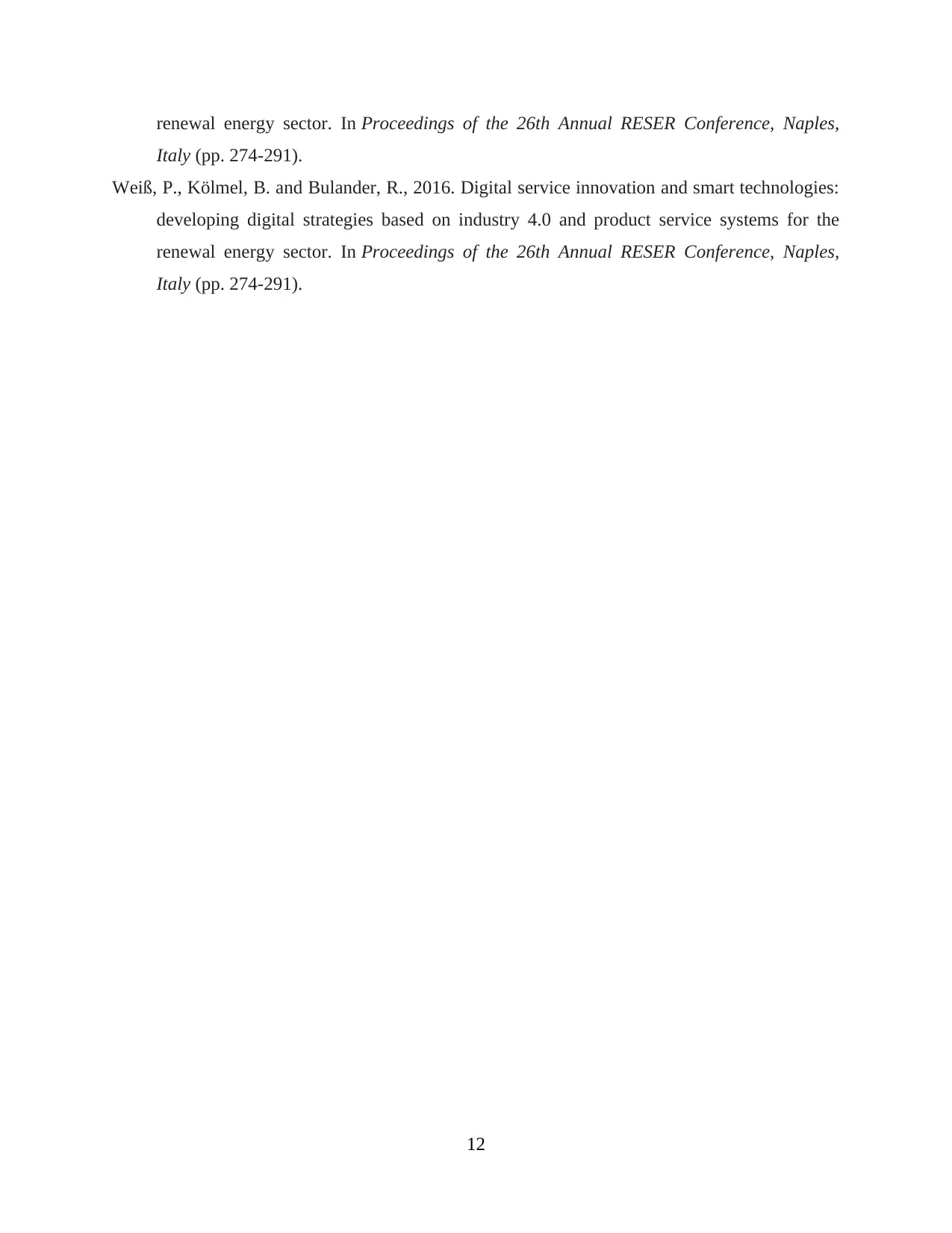
renewal energy sector. In Proceedings of the 26th Annual RESER Conference, Naples,
Italy (pp. 274-291).
Weiß, P., Kölmel, B. and Bulander, R., 2016. Digital service innovation and smart technologies:
developing digital strategies based on industry 4.0 and product service systems for the
renewal energy sector. In Proceedings of the 26th Annual RESER Conference, Naples,
Italy (pp. 274-291).
12
Italy (pp. 274-291).
Weiß, P., Kölmel, B. and Bulander, R., 2016. Digital service innovation and smart technologies:
developing digital strategies based on industry 4.0 and product service systems for the
renewal energy sector. In Proceedings of the 26th Annual RESER Conference, Naples,
Italy (pp. 274-291).
12
1 out of 14
Related Documents
Your All-in-One AI-Powered Toolkit for Academic Success.
+13062052269
info@desklib.com
Available 24*7 on WhatsApp / Email
![[object Object]](/_next/static/media/star-bottom.7253800d.svg)
Unlock your academic potential
© 2024 | Zucol Services PVT LTD | All rights reserved.





